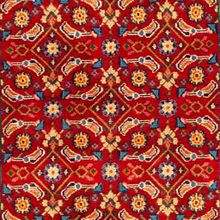Difference between revisions of "Moud Rug"
Jump to navigation
Jump to search
| Line 25: | Line 25: | ||
|Common motifs & patterns = | |Common motifs & patterns = | ||
|Common sizes = | |Common sizes = | ||
| − | |Common colors = Navy Blue, Red, Blue | + | |Common colors = Navy Blue, Red, Blue, Brown |
|Dyeing method = [[Natural Dyeing|Natural]], [[Synthetic Dyeing|Synthetic]] | |Dyeing method = [[Natural Dyeing|Natural]], [[Synthetic Dyeing|Synthetic]] | ||
|Pile material = [[Wool]], [[Silk]] | |Pile material = [[Wool]], [[Silk]] | ||
Revision as of 05:36, 16 September 2019
| Moud Rug | |
|---|---|
 Design of Mood Rug (Rugman) | |
| General information | |
| Name | Mood Rug |
| Original name | قالی مود |
| Alternative name(s) | Mood Carpet |
| Origin | |
| Category | Village |
| Technical information | |
| Common designs | Medallion, Herati (Fish) |
| Common colors | Navy Blue, Red, Blue, Brown |
| Dyeing method | Natural, Synthetic |
| Pile material | Wool, Silk |
| Foundation material | Cotton |
| Knot type | Asymmetrical (Persain), Jufti |
Mood rugs, reputed to be among the finest in the world, are hand woven in the city of Mashad in the Province of Khorassan. This great weaving center is also a trade center for the rugs produced in the neighboring towns and villages. You may notice that Mood rugs have some characteristics that are similar to a rug produced in Birjand. Although most are woven in workshops in the city, it is possible to find occasional Mood rugs that have been woven on a home loom. Skilled artisans use the asymmetrical Persian knot in the creation of this very special carpet as it offers more precision when weaving the intricately detailed patterns.[citation needed]